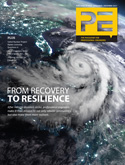November/December 2017
Imagining the Impossible
BY EVA KAPLAN-LEISERSON
 In discussions about infrastructure resiliency, design is often top of mind. But another aspect that can’t be ignored, pre- or post-disaster, is policy.
In discussions about infrastructure resiliency, design is often top of mind. But another aspect that can’t be ignored, pre- or post-disaster, is policy.
Engineers may be reluctant to get involved in this area, preferring to keep to the technical arenas where they feel most confident. After all, NSPE’s Code of Ethics stipulates that engineers should “perform services only in areas of their competence.”
But some PEs point to the need for engineers to contribute their technical knowledge to policy discussions, seeing such actions as part of the ethical responsibilities inherent in their roles.
The work of each of these professional engineers embodies this viewpoint. And they urge more professionals to join their ranks.
 Sandra Knight, P.E.
Sandra Knight, P.E.
President
WaterWonks LLC;
Senior Research Engineer
Center for Disaster Resilience
Department of Civil and Environmental Engineering
University of Maryland, College Park;
Former Deputy Associate Administrator
Federal Emergency Management Agency
“To be resilient, you have to imagine the impossible,” says Knight. “We keep limiting our framework for what bad thing can happen, and it keeps exceeding our expectations.”
After serving in roles at the Army Corps of Engineers, the National Oceanic and Atmospheric Administration, and FEMA, Knight founded a company that advises public and private organizations on areas including disaster resilience.
Her part-time academic position focuses on this topic as well. Knight has garnered grants for research on resiliency metrics and ways to merge the professions of project and disaster management. She explains that her role is often serving as a translator between research and operations.
Knight highlights the more than 50 inches of rainfall in Houston during Hurricane Harvey as an example of the need to think beyond the most probable events and prepare for lesser probability, but higher catastrophe, occurrences.
But one obstacle is what she calls the nation’s “fix as fail” mindset. Knight points out that only 15% of FEMA’s budget is set aside for mitigation, with the rest going to response and recovery. “We’re constantly cleaning up the mess rather than planning ahead of time,” the PE says.
Engineers, as the professionals who design and build infrastructure, are well positioned to put their skills toward not just recovery but long-term resilience, Knight says. She believes that because PEs understand the technical complications of policy, it’s important for them to take a role in shaping it.
PEs do have a “moral obligation” to examine the criteria and standards they design for, she says, and “it’s our duty to be an advocate for making things stronger and safer.”
Engineers should learn as much as they can about disaster management, Knight emphasizes, and bring that knowledge to their work. For example, a PE working on a recovery project for a school destroyed during a tornado could insist that a shelter be included, even if it’s not stipulated in the building code. Or an engineer working on a project in a flood zone could ensure that the HVAC system isn’t put in the basement.
We need to train engineers to think about resilience, Knight says, rather than just to complete projects and consider what happens to them someone else’s problem.
Broadening this outlook could attract more diversity into the profession, she believes, because there’s a value proposition: “People want to help other people.”
But getting engineers to think beyond narrow perspectives is difficult with what she deems the “rigid” course curriculum of accredited schools. What’s needed, she says, is impact- or problem-based education, along with ways to incentivize such activities.
Says Knight: “Resilience is a multi-disciplinary sport.”
 David Lapp, P.Eng
David Lapp, P.Eng
Practice Lead Globalization and Sustainable Development
Engineers Canada;
Secretariat
Public Infrastructure Engineering Vulnerability Committee
More than a decade ago, Engineers Canada and partners joined together to examine the vulnerability of the country’s infrastructure to climate change. As project manager Lapp explains, the resulting qualitative assessment was “built by engineers for engineers.”
The protocol the committee developed generates a risk profile that can help determine priorities and guide decision makers. And cost effectiveness is a key goal. “It’s not always about building something bigger or stronger,” Lapp notes. “It’s being smart about it.” For example, some recommendations focus on operations and maintenance.
The protocol is now being applied internationally, including in 11 countries in Africa that are working together to develop the Nile Basin.
Within Canada, Lapp has been providing advice to various levels of government on incorporating such risk assessment into infrastructure planning and procurement. According to the P.Eng, concern has been growing “exponentially.”
“You felt like you were in the wilderness for a few years,” he explains. “Now people are coming to us and saying, ‘We’d like to apply the protocol; we need to adapt and make the infrastructure more resilient.’”
“Human misery” is a key driver, Lapp says. Extreme weather events come with social costs, and “people are traumatized.”
In addition, he says businesses are waking up to the risks to their continuity and potential economic costs.
Lapp stresses the importance of taking swift action on climate change effects. “You’re going to pay so big if you just ignore it,” he says. “It’s just a matter of when, not if.”
While some politicians may fear a big price tag, Lapp says engineers can help with that. “If you’re ignorant about it, it will cost a fortune. If you’re informed, and engineers will be part of the practitioners informing you, you will be able to make good policy that will be cost-effectively implemented.”
Lapp says there’s a growing number of engineers who believe they need to do more than just execute on jobs while considering the rest out of their control. Climate change effects are so pervasive, he says, “that to ignore it is unethical, frankly.”
In addition, Lapp says, engineers who don’t consider the impacts could be held professionally liable.
Not everyone has to be an expert, he emphasizes, but all engineers should at least have an awareness of the effects on the practice and public, and should find opportunities to increase their competence.
Lapp believes that, as problem solvers and implementers, engineers will be important partners in collaborative, multidisciplinary solutions. Climate change adaptation can be a manageable issue, he says, with “dedicated and clever effort.”
 Larry Larson, P.E.
Larry Larson, P.E.
Director Emeritus
Senior Policy Advisor
Association of State Floodplain Managers
The mission of the Association of State Floodplain Managers is two-fold: reduce flood damages and protect the beneficial functions of floodplains.
The programs of 26 federal agencies can impact flooding, founding member Larson explains, including FEMA, the Army Corps of Engineers, the Environmental Protection Agency, and the Department of Transportation.
The association’s National Flood Programs and Policies in Review provides 400 recommendations sorted into categories such as mapping, mitigation, regulation, and data.
While some of these topics have been getting more recognition lately, Larson says, some have not but should be. For instance, he calls the disaster relief program one of the biggest current problems. “It’s the 500,000-pound gorilla in the room.”
The issue, Larson says, is that the system rewards the “bad actors.” The National Flood Insurance Program was created to help communities and states avoid building in high-risk areas, but it’s “really doing almost the opposite. It maps the hazard area, the high-risk area, and then it shows you how to build in it.”
There’s a “perverse incentive,” Larson says, because the communities and the states are the ones who receive increased tax revenue from development, but if an area gets flooded it’s the federal taxpayer who provides disaster relief. “I tell everyone, you don’t use the words ‘federal government,’ because everybody thinks that’s somebody else.” He continues, “The federal taxpayer: that means you.”
One concept, first proposed under the Obama administration and currently being examined by the Trump administration, is a “disaster deductible.” With this idea, the state has to put up an initial amount, which is calculated based on both past disasters and actions taken that can “buy down” the deductible. That could include, for instance, requiring all communities in the state to adopt the latest building codes with flood standards.
This type of solution would “reward those who do better, not those who do the least,” Larson says.
Another important step, the PE believes, is to change flood mapping. FEMA mapping looks only at past events and projects a similar future. But the concept of “what happened in the past is what’s going to happen in the future” no longer makes sense, Larson says. “The flood levels are going to increase, the rainfalls are increasing. There’s no looking back and projecting forward.”
Some communities, such as Charlotte-Mecklenburg in North Carolina, are taking a more forward-looking approach. Predicting future development in a small watershed, Larson explains, they decided to map to future conditions. “They didn’t want people building and then getting flooded, thinking they were following the rules.”
Communities need to think long-term, he says—for instance, in rebuilding after a flooding disaster. “There’s nothing more short-sighted” than rebuilding exactly the same, he says. If you’re going to rebuild, think about the future and “do it smart and safe.”
Like Lapp, the policy advisor points to potential liability for engineers who don’t take evolving conditions into account. “It’s very predictable,” he says. “Courts are no longer saying it’s an act of God.”
PEs can play an important role in advising communities, Larson says, for example by calculating future conditions, looking at the big picture of future development, and speaking up about potential adverse impacts. He believes engineers have an obligation as professionals to do so.
“Once they think about it,” he says, “they will realize this is an ethical question.”
 Cris B. Liban, P.E.
Cris B. Liban, P.E.
Executive Officer
Environmental Compliance and Sustainability,
Program Management
Los Angeles County Metropolitan Transportation Authority;
Member, California Climate-Safe Infrastructure Working Group
With more than a decade of sustainability experience at LA Metro, Liban was recently appointed to a state taskforce on adapting infrastructure for climate change.
The California Climate-Safe Infrastructure Working Group is joining professional engineers and architects with climate scientists. The group’s goal: setting best practices for integrating scientific data on projected climate change impacts into state infrastructure design, construction, operations, and maintenance.
The working group was mandated in state legislation last fall. As stipulated, the group will examine informational and institutional barriers, critical information needed by engineers to address climate change impacts, and how to select an appropriate engineering design for a range of future climate scenarios.
Liban says LA Metro has been engaged in similar efforts for the last decade, working with contractors and designers to make the transportation system in Los Angeles more resilient and climate adaptive.
Sustainability is one of the agency’s core values, with longtime efforts in this area. Sustainable infrastructure built by LA Metro in the last decade has served as a model to others within the transportation industry, providing lessons learned on construction, operation, and maintenance.
The biggest challenge, Liban explains, is that engineers are used to designing up to a certain standard, “but for better or worse, in terms of climate and the issues related, there really has been no particular standard.”
For example, an engineer asked to design a building for a higher heat baseline would have to ask the owner what that temperature standard should be, Liban says, and would not be able to guarantee the service and construction.
Engineers have been viewed as the technical experts in these conversations, he says. But a city engineer asked to rebuild an area after a hurricane or flooding based on current standards would not know how to react, since “the current standards don’t address these issues that we’re seeing right now” or potential future conditions.
That leads to another dilemma, which the PE says the working group will have to resolve: Do you provide prescriptive numbers or a mechanism to generate them? “It’s something that’s subject to debate.”
Prescriptive numbers may become outdated as science evolves, but Liban says in his experience, leaving things too open has resulted in confusion for contractors and designers and a significant number of change orders. “Maybe putting a little bit of prescription in there that’s empirically-based would assist us in fulfilling the overall vision,” he says. “Right now, people are saying this is too general, we can’t design on this.”
The California working group has been asked to generate initial recommendations by next summer, then final recommendations after public hearings.
Liban hopes the work can bring awareness to the need to build above and beyond current standards, not only for California engineers but also for those nationwide. The state is not consciously looking to be a model, he says, but “we expect to be.”
Taxpayers demand quality, safe, and reliable infrastructure, Liban says, and “we have an obligation to deliver sustainable and resilient infrastructure to them.”
Learn More


 Volunteering at NSPE is a great opportunity to grow your professional network and connect with other leaders in the field.
Volunteering at NSPE is a great opportunity to grow your professional network and connect with other leaders in the field. The National Society of Professional Engineers (NSPE) encourages you to explore the resources to cast your vote on election day:
The National Society of Professional Engineers (NSPE) encourages you to explore the resources to cast your vote on election day:
